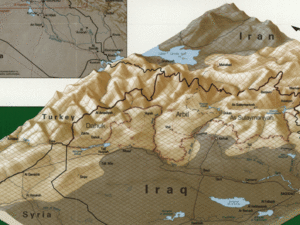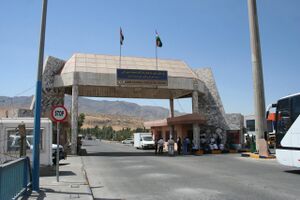الحدود التركية العراقية
| Iraq-Turkey border الحدود العراقية التركية (عربية) Irak–Türkiye sınırı (تركية) سنووری عێراق و تورکیا (كردي) | |
|---|---|
 Map of the Iraq–Turkey border | |
| الخصائص | |
| الأطراف | |
| الطول | 331 km (206 mi)[1] |
| التاريخ | |
| تأسست | 1926 (Treaty of Ankara (1926)) |
| To establish the border between Iraq and Turkey | |
| الشكل الحالي | Active |
| Border between Iraq and Turkey | |
| المعاهدات | Treaty of Ankara (1926) |
| هوامش | The border region is mountainous and predominantly populated by Kurds on both sides. Tensions related to Kurdish insurgency persist. |
يبلغ طول الحدود التركية العراقية 331 كيلومتراً، وتمتد من نقطة حدود ثلاثية مع سوريا في الغرب إلى نقطة حدود ثلاثية مع إيران في الشرق.[2]
الوصف
The border starts in the west at the tripoint with Syria at the confluence of Tigris river and Little Khabur river. It then follows the latter river eastwards, and then the Hezil Suyu river to the north-east. The border then turns eastwards overland via series of irregular lines over mountain crests and small streams, eventually turning southwards to connect to the Hajji Bak (Hacibey Suyu) river. It then follows this river north-eastwards to the Iranian tripoint. The border region is extremely mountainous and is populated almost exclusively by Kurds on both sides.
التاريخ
At the start of the 20th century the Ottoman Empire controlled what is now Turkey and Iraq.[3] During the First World War an Arab Revolt, supported by Britain, succeeded in removing the Ottomans from most of the Middle East. As a result of the secret 1916 Anglo-French Sykes–Picot Agreement Britain gained control of the Ottoman Vilayets of Mosul, Baghdad and Basra, which it organised into the mandate of Iraq in 1920.
By the 1920 Treaty of Sèvres Anatolian Turkey was to be partitioned, with the areas north of the Mosul Vilayet to be included within an autonomous or independent Kurdish state.[3][4] Turkish nationalists were outraged at the treaty, contributing to the outbreak the Turkish War of Independence; the Turkish success in this conflict rendered Sèvres obsolete.[3] By the 1923 Treaty of Lausanne Turkey's independence was recognised and a far more generous territorial settlement was agreed upon, albeit at the cost of Turkey formally renouncing any claim to Arab lands.[5] As a provisional measure, the former northern border the Mosul Vilayet was to serve as a frontier between British-controlled Iraq and Turkey, with a more precise delimitation to be agreed upon later.[3]
British and Turkish officials met in 1924 but were unable to determine a mutually satisfactory border, and the matter was referred to the League of Nations.[3] In October 1925 the League proposed a border (the ‘Brussels line’) that was essentially the same as that of the northern limits of the old Mosul Vilayet.[3][6] After further deliberations, the League formally recommend in July 1925 that the Brussels line be utilised, a view endorsed by the Permanent Court of International Justice at the Hague in November 1925.[3] On 5 June 1926 Britain and Turkey signed the Treaty of Ankara, by which both states recognised the Brussels line (with some minor modifications) as the frontier.[3][7] The border was then demarcated on the ground in 1927.[3]
Generally cordial, relations between Iraq and Turkey became strained following the Gulf War (1990–91); this resulted in an autonomous Kurdish area being established in northern Iraq which provided sanctuary for Kurdish guerrillas operating in the south-east Turkey.[8] Since then Turkey has conducted numerous military incursions across the border in a bid to counter what it sees as Kurdish terrorism.[9][10][11]
المعابر
| المحافظة | المحافظة | أُفتتحت | المسار في تركيا | المسار في العراق | الحالة | ||
|---|---|---|---|---|---|---|---|
| Habur | Şırnak | Zakho | Duhok | 18 July 1969 | مفتوحة | ||
| Gülyazı | Şırnak | ? | ? | 24 يناير 2012 | ? | ? | مغلقة |
| Şemdinli-Derecik | Hakkâri | ? | ? | 14 فبراير 2011 | ? | ? | مغلقة |
| Çukurca-Üzümlü | Hakkâri | Sar Zeri | Erbil | 7 مايو 2015 | ? | ? | Open |
انظر أيضاً
المصادر
- ^ "Türkiyenin Komşuları ve Coğrafi Sınırları". 14 February 2016. Archived from the original on 14 February 2016.
- ^ CIA World Factbook – Iraq, https://www.cia.gov/the-world-factbook/countries/iraq/, retrieved on 4 April 2020
- ^ أ ب ت ث ج ح خ د ذ International Boundary Study No. 27 – Iraq-Turkey Boundary, 30 January 1964, https://fall.fsulawrc.com/collection/LimitsinSeas/IBS027.pdf, retrieved on 4 April 2020
- ^ Helmreich, Paul C. (1974). From Paris to Sèvres: The Partition of the Ottoman Empire at the Peace Conference of 1919–1920. Columbus, Ohio: Ohio State University Press. ISBN 9780814201701.
- ^ Treaty of Peace with Turkey signed at Lausanne, Lausanne, Switzerland, 24 July 1923, http://wwi.lib.byu.edu/index.php/Treaty_of_Lausanne, retrieved on 28 November 2012
- ^ The Geography of the Mosul Boundary: Discussion "The Geographical Journal" 1926
- ^ "Treaty Between the United Kingdom and Iraq and Turkey Regarding the Settlement of the Frontier Between Turkey and Iraq, Together with Notes Exchanged". The American Journal of International Law. 21 (4): 136–143. 2018. doi:10.2307/2213009. JSTOR 2213009. S2CID 246007497.
- ^ Fawcett, L. (2001). "Down but not out? The Kurds in International Politics". Review of International Studies. 27 (1): 109–118 [p. 117]. doi:10.1017/S0260210500011098. S2CID 146771496.
- ^ "Turkey hits PKK targets in Iraq, Syria". Hurriet Daily News. 25 April 2017. Retrieved 25 April 2017.
- ^ "Unwelcome Guests: The Turkish Military Bases in Northern Iraq". The Jamestown Foundation. Retrieved 24 April 2016.
- ^ "Iraq to Expel Foreign Troops, End Turkish Military Presence - Al-Monitor: the Pulse of the Middle East". Al-Monitor. 3 October 2012. Retrieved 24 April 2016.

